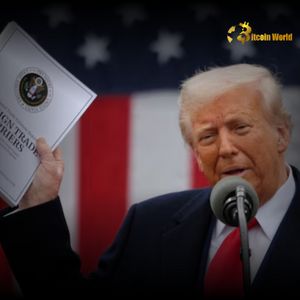US Court Ruling Creates Crucial Uncertainty Over Trump Tariffs
7 min read
BitcoinWorld US Court Ruling Creates Crucial Uncertainty Over Trump Tariffs In a move that has sent ripples through the world of international commerce and economic forecasting, a recent development concerning the contentious Trump tariffs has emerged from the United States judicial system. A US court ruling from a federal circuit court of appeal has temporarily paused a previous decision that went against these reciprocal tariffs. This unexpected halt signals a period of deliberation by the court, as reported by the Walter Bloomberg economic news account on X, leaving businesses and economists pondering the potential economic impact and future of trade policy . What Were the Trump Tariffs and Why the Challenge? To understand the significance of this US court ruling , we need to rewind slightly. The tariffs in question were largely imposed during the administration of former President Donald Trump, often targeting goods from countries like China, citing concerns over unfair trade practices, national security, or as leverage in trade negotiations. These weren’t just minor adjustments; they represented a significant shift in U.S. trade policy , moving towards a more protectionist stance. These tariffs, applied to various imports ranging from steel and aluminum to a wide array of Chinese goods under Section 301 investigations, were met with mixed reactions. While proponents argued they protected domestic industries and jobs, critics highlighted increased costs for consumers and businesses, retaliatory tariffs from other nations, and disruptions to established supply chains. The legal challenges against these tariffs often centered on the authority under which they were imposed, questioning whether the executive branch overstepped its powers or failed to follow proper administrative procedures. A ruling against the tariffs, as was temporarily reversed, would have potentially invalidated some of these measures, leading to significant refunds for importers and a reshaping of trade relationships. Decoding the US Court Ruling: What Does “Temporarily Halted” Mean? The core of the recent news is the federal circuit court’s decision to temporarily halt the ruling that found fault with the Trump tariffs . What exactly does this mean? It’s a Pause, Not a Reversal: The court has not overturned the previous ruling on the merits. It has simply put it on hold. Time for Consideration: The court stated it needs time to review ‘related filings’. This could include appeals, briefs from involved parties (like the government defending the tariffs or importers challenging them), or requests for clarification. Status Quo (for now): While the halt is in place, the tariffs that were challenged and found unlawful in the lower ruling likely remain in effect. Businesses cannot currently rely on the invalidated ruling to avoid paying the tariffs or seek refunds based on that specific decision. Uncertain Duration: The term ‘temporarily’ is key. The halt could last days, weeks, or potentially months, depending on the complexity of the filings and the court’s schedule. This temporary halt introduces a layer of uncertainty. Businesses that might have been preparing for the potential removal or invalidation of certain tariffs based on the previous ruling now face ambiguity. Will the original ruling be upheld after the court’s review, or will the halt be made permanent, or will the court issue a new decision? Crucial Economic Impact: Who Feels the Effects of This Trade Policy Uncertainty? Any shift, or potential shift, in trade policy carries significant weight for the economy, and this US court ruling is no exception. The uncertainty surrounding the future of these tariffs has a crucial economic impact that resonates across various sectors: Challenges for Businesses: Supply Chain Disruptions: Companies that import goods subject to these tariffs face unpredictable costs. This makes long-term planning difficult. Do they absorb the cost, pass it to consumers, or try to find alternative suppliers? Increased Costs: Tariffs are essentially taxes on imports. These costs can increase operating expenses for manufacturers, retailers, and other businesses relying on imported components or finished goods. Investment Hesitation: Uncertainty about trade rules can make businesses hesitant to invest in new projects, expand operations, or commit to long-term contracts that depend on stable import costs. Competitive Disadvantage: U.S. companies using tariffed imports might be at a disadvantage compared to international competitors who do not face these costs. Impact on Consumers: Higher Prices: Businesses often pass increased costs from tariffs onto consumers in the form of higher prices for goods ranging from cars and appliances to clothing and electronics. Reduced Variety: Some imported goods might become too expensive to stock, potentially reducing consumer choice. Broader Economic Effects: Inflationary Pressure: Tariffs contribute to inflation by increasing the cost of imported goods and reducing competition. Strained International Relations: Ongoing disputes over tariffs can strain diplomatic and trade relationships with key partners, potentially leading to retaliatory measures. Impact on Global Trade Flows: Uncertainty in a major economy’s trade policy can influence global trade patterns as countries and companies seek stability. While the direct beneficiaries of tariffs are intended to be domestic industries gaining protection, the broader economic impact often involves a complex web of winners and losers, with uncertainty being a net negative for overall economic stability and growth. Navigating the Waters of Global Trade Amidst Tariff Disputes The temporary halt on the ruling against Trump tariffs underscores the volatile nature of global trade in the current geopolitical climate. Trade relationships are not static; they are influenced by political shifts, economic pressures, and legal challenges. Examples of Affected Areas: Historically, the Trump-era tariffs impacted a wide range of goods. For instance: Steel and Aluminum: Tariffs were applied globally based on national security grounds (Section 232). Chinese Goods: Extensive tariffs were placed on thousands of products under Section 301, covering everything from machinery and electronics to furniture and plastics. Goods from Allies: At times, tariffs or the threat of tariffs were used in negotiations with traditional allies over issues like automobile imports or digital services taxes. Each of these categories involves complex international supply chains. A legal challenge and subsequent temporary halt create ripples through these networks, affecting manufacturers in multiple countries, shipping companies, logistics providers, and ultimately, the end consumers. Actionable Insights (for businesses/stakeholders): Given the ongoing uncertainty stemming from the US court ruling and the broader landscape of trade policy : Monitor Developments Closely: Stay informed about the court’s decision and any related government actions. Assess Supply Chain Vulnerabilities: Identify dependencies on goods subject to potential tariff changes. Explore diversification options. Engage with Trade Experts: Consult with legal and trade policy experts to understand potential outcomes and plan accordingly. Advocate: Businesses impacted by tariffs can engage with industry associations and policymakers to voice their concerns. The situation highlights the intricate link between domestic legal processes and international commerce. A decision made in a U.S. courtroom can have tangible effects on factories in Asia, shipping lanes across oceans, and prices in shops worldwide. What’s Next After This US Court Ruling? The temporary halt is just one step in a potentially lengthy legal and political process. What could happen next? Court’s Final Decision: The federal circuit court will eventually issue a decision on the merits of the appeal or the filings it is considering. It could uphold the previous ruling against the tariffs, reverse it, or send it back to a lower court for further review. Government Response: Regardless of the court’s final decision, the executive branch (the current administration) has options. They could choose to maintain, modify, or remove tariffs based on their own policy goals, potentially independent of the specific legal challenge, or respond to the court’s directives. Further Appeals: Depending on the outcome at the circuit court level, either party could potentially seek further review, possibly petitioning the Supreme Court, although this is not guaranteed. Political Considerations: Trade policy is often a political hot potato. The upcoming political landscape will undoubtedly influence the long-term trajectory of tariffs, regardless of judicial outcomes. For those watching the broader markets, including the cryptocurrency space, events like this, while not directly tied to crypto, contribute to the overall climate of economic uncertainty. Major shifts in global trade and potential impacts on inflation, corporate earnings, and investor confidence can indirectly influence sentiment and capital flows across all asset classes. Conclusion: Navigating the Waves of Trade Uncertainty The temporary halt by a US court ruling on a decision challenging Trump tariffs serves as a potent reminder of the complexities and uncertainties inherent in modern trade policy . It underscores how legal battles over past executive actions can continue to shape the present and future of the economy. The crucial economic impact of tariffs, affecting everything from corporate balance sheets to household budgets, means that developments like this are closely watched by businesses, investors, and governments worldwide. While the final outcome of this specific legal challenge remains to be seen, the period of temporary halt highlights the ongoing volatility in global trade . Businesses must remain agile, prepared for potential shifts in costs and market dynamics. For the wider public and market participants, it’s a signal to continue monitoring the intersection of law, politics, and economics, as decisions made in courtrooms and government offices can have far-reaching effects on the global financial landscape. To learn more about the latest economic trends and their potential impact on markets, explore our articles on key developments shaping global trade and economic policy. This post US Court Ruling Creates Crucial Uncertainty Over Trump Tariffs first appeared on BitcoinWorld and is written by Editorial Team

Source: Bitcoin World



